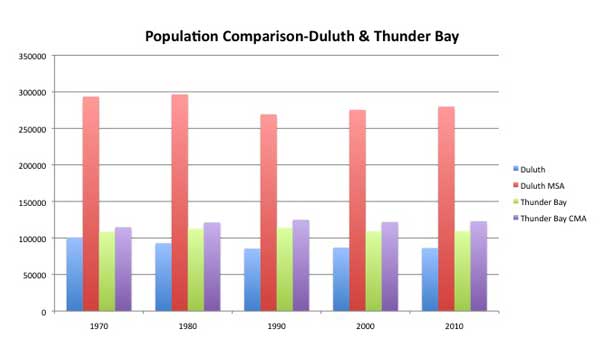 THUNDER BAY – Thunder Bay residents flock to visit and shop in Duluth, Minnesota and continually remark how robust and vibrant Duluth’s waterfront and downtown area is when compared to Thunder Bay. This appears to be all the more surprising given that the population of the city of Thunder Bay – at about 110,000 people – is much larger than the city of Duluth, which stands at about 86,000. One can point to the fact that much of Duluth’s visitation and tourism actually comes from nearby Minneapolis-St. Paul (a two hour drive) which has a population of nearly three and a half million people as well as from Wisconsin.
THUNDER BAY – Thunder Bay residents flock to visit and shop in Duluth, Minnesota and continually remark how robust and vibrant Duluth’s waterfront and downtown area is when compared to Thunder Bay. This appears to be all the more surprising given that the population of the city of Thunder Bay – at about 110,000 people – is much larger than the city of Duluth, which stands at about 86,000. One can point to the fact that much of Duluth’s visitation and tourism actually comes from nearby Minneapolis-St. Paul (a two hour drive) which has a population of nearly three and a half million people as well as from Wisconsin.
However, this is only a partial explanation given that downtown and waterfront areas are not only a tourism attraction but are also a focus for your own community’s activity. The fact is, Duluth is a much larger community than Thunder Bay when the population of the surrounding St. Louis, Carlton and Douglas counties – the Duluth metropolitan statistical area – is considered.
There are nearly 280,000 people living in immediate the Duluth area as compared to about 125,000 in the immediate Thunder Bay vicinity or census metropolitan area. Basically, the Duluth area has 2.2 times the population of the Thunder Bay area and as a result can support a much denser downtown core and waterfront area even without visitors from Minneapolis-St. Paul (and Thunder Bay).
The accompanying figure plots population for the two cities and their immediate vicinities for the period 1970 to 2010. One other thing to note, whereas Thunder Bay’s CMA population has essentially stagnated since 1990, the Duluth MSA has actually seen some noticeable growth. Since 1990, the Duluth MSA population has grown by almost 4 percent whereas Thunder Bay’s CMA population has shrunk by about 1.5 percent. The implications? When it comes to fostering economic activity, population size does matter.
Livio Di Matteo
 Livio Di Matteo is an economist in Thunder Bay, Ontario specializing in public policy, health economics, public finance and economic history. Livio Di Matteo is a graduate of the Fort William Collegiate Institute (1898-2005) whose school motto “Agimus Meliora” has served as a personal inspiration. Livio Di Matteo holds a PhD from McMaster University, an MA from the University of Western Ontario and an Honours BA from Lakehead University. He is Professor of Economics at Lakehead University where he has served since 1990. His research has explored the sustainability of provincial government health spending, historical wealth and asset holding and economic performance and institutions in Northwestern Ontario and the central North American economic region. His historical wealth research using census-linked probate records is funded by grants from the Social Sciences and Humanities Research Council of Canada. He has constructed, assembled and analyzed nearly 12,000 estate files for Ontario over the period 1870 to 1930. Livio Di Matteo writes and comments on public policy and his articles have appeared in the National Post, Toronto Star, the Winnipeg Free Press and Thunder Bay Chronicle-Journal and NetNewsledger.com. Livio Di Matteo has had an entry in Canadian Who’s Who since 1995.
Livio Di Matteo is an economist in Thunder Bay, Ontario specializing in public policy, health economics, public finance and economic history. Livio Di Matteo is a graduate of the Fort William Collegiate Institute (1898-2005) whose school motto “Agimus Meliora” has served as a personal inspiration. Livio Di Matteo holds a PhD from McMaster University, an MA from the University of Western Ontario and an Honours BA from Lakehead University. He is Professor of Economics at Lakehead University where he has served since 1990. His research has explored the sustainability of provincial government health spending, historical wealth and asset holding and economic performance and institutions in Northwestern Ontario and the central North American economic region. His historical wealth research using census-linked probate records is funded by grants from the Social Sciences and Humanities Research Council of Canada. He has constructed, assembled and analyzed nearly 12,000 estate files for Ontario over the period 1870 to 1930. Livio Di Matteo writes and comments on public policy and his articles have appeared in the National Post, Toronto Star, the Winnipeg Free Press and Thunder Bay Chronicle-Journal and NetNewsledger.com. Livio Di Matteo has had an entry in Canadian Who’s Who since 1995.
This article was originally posted on Livio Di Matteo’s NORTHERN ECONOMIST Blog at http://ldimatte.shawwebspace.ca.






